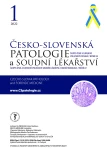Uterus transplantation in the treatment of female infertility: the pathologist’s perspective
Authors:
Jan Balko 1; Josef Zámečník 1; Roman Chmel 2
Authors‘ workplace:
Ústav patologie a molekulární medicíny 2. LF UK a FN Motol, Praha
1; Gynekologicko-porodnická klinika 2. LF UK a FN Motol, Praha
2
Published in:
Čes.-slov. Patol., 58, 2022, No. 1, p. 57-60
Category:
Overview
Uterus transplantation is a new experimental treatment method of absolute uterine factor infertility which affects 3-5% of infertile women. Absolute uterine factor infertility includes infertile women with agenesis or severe malformation of the uterus, several acquired uterine diseases causing infertility, and patients of fertile age after hysterectomy because of various causes. Uterus transplantation is considered a new method of assisted reproduction which allows women with absolute uterine factor infertility to have own biological offspring. However, uterus transplantation is considered a radical method of reproduction by some ethicists. Nevertheless, recent analysis of newborns from transplanted uterus has shown high level of childbirths of mature and near-to-term newborns and did not confirm increased risk for both babies and mothers. Therefore, together with gestational surrogacy and adoption, uterus transplantation is nowadays considered promising and unique solution for women with absolute uterine factor infertility.
Similarly to other solid organ transplants, the pathologist should be an integral part of the multidisciplinary uterus transplantation research teams. The primary role of the pathologist is histopathological evaluation of rejection changes in the biopsy samples from the ectocervix of the uterine allografts that is based on the provisional scoring system suggested by Swedish pioneers in uterus transplantation research. As the word provisional suggests, this scoring system is continuously studied and the principles of the evaluation of rejection after uterus transplantation could be adjusted in the future.
Keywords:
Transplantation – Uterus – rejection – ectocervical biopsy – grading
Sources
1. Brännström M, Dahm Kähler P, Greite R, Mölne J, Díaz-García C, Tullius SG. Uterus Transplantation: A Rapidly Expanding Field. Transplantation 2018; 102(4): 569-577.
2. Chmel R. Syndrom Mayer-Rokitansky-Küster-Hauser, diagnostické a terapeutické možnosti. Praha: Maxdorf; 2021 : 54-72.
3. Fageeh W, Raffa H, Jabbad H, Marzouki A. Transplantation of the human uterus. Int J Gynaecol Obstet 2002; 76(3): 245-51.
4. Brännström M, Johannesson L, Dahm - Kähler P, et al. First clinical uterus transplantation trial: a six-month report. Fertil Steril 2014; 101(5): 1228-1236.
5. Brännström M, Boccio MV, Pittman J. Uterus transplantation: the science and clinical update. Curr Opin Physiol 2020; 13 : 49-54.
6. Brännström M, Johannesson L, Bokström H, et al. Livebirth after uterus transplantation. Lancet 2015; 385(9968): 607-616.
7. Dahm-Kähler P, Diaz-Garcia C, Brännström M. Human uterus transplantation in focus. Br Med Bull 2016; 117(1): 69-78.
8. Ejzenberg D, Andraus W, Baratelli Carelli Mendes LR, et al. Livebirth after uterus transplantation from a deceased donor in a recipient with uterine infertility. Lancet 2019; 392(10165): 2697-2704.
9. Chmel R, Nováčková M, Pastor Z, Froněk J. The interest of women with Mayer–Rokitansky – Küster–Hauser syndrome and laparoscopic Vecchietti neovagina in uterus transplantation. J Pediatr Adolesc Gynecol 2018; 31(5): 480-484.
10. Chmel R, Nováčková M, Janoušek L, et al. Revaluation and lessons learned from the first 9 cases of a Czech uterus transplantation trial: four deceased donor and 5 living donor uterus transplantations. Am J Transplant 2019; 19(3): 855-864.
11. Chmel R, Čekal M, Pastor Z, et al. Assisted reproductive techniques and pregnancy results in women with Mayer–Rokitansky–Küster – Hauser syndrome undergoing uterus transplantation: the Czech experience. J Pediatr Adolesc Gynecol 2020; 33(4): 410-414.
12. Testa G, Koon EC, Johannesson L. Living Donor Uterus Transplant and Surrogacy: Ethical Analysis According to the Principle of Equipoise. Am J Transplant 2017; 17(4): 912-916.
13. Chmel R, Nováčková M, Čekal M, Chmel R, Pastor Z. Aktuální etické aspekty léčby absolutního uterinního faktoru neplodnosti pomocí transplantace dělohy. Česká gynekologie 2021; 86(1): 40-45.
14. Chmel, R, Nováčková M, Pastor Z. Lessons learned from the Czech uterus transplant trial related to surgical technique that may affect reproductive success. Aust N Z J Obstet Gynaecol 2020; 60(4): 625-627.
15. Broecker V, Brännström M, Ekberg J, Dahm - Kähler P, Mölne J. Uterus transplantation: histological findings in explants at elective hysterectomy. Am J Transplant 2021; 21(2): 798-808.
16. Brucker SY, Strowitzki T, Taran FA, et al. Living - donor uterus transplantation: Pre-, intra-, and postoperative parameters relevant to surgical success, pregnancy, and obstetrics with live births. J Clin Med 2020; 9 : 2458.
17. Mölne J, Broecker V, Ekberg J, Nilsson O, Dahm-Kähler P, Brännström M. Monitoring of human uterus transplantation with cervical biopsies: a provisional scoring system for rejection. Am J Transplant 2017; 17(6): 1628 - 1636.
18. Balko J, Nováčková M, Škapa P, et al. Histopathological examination of the ectocervical biopsy in non-transplanted uteri: A study contributing to the provisional scoring system of subclinical graft rejection after uterus transplantation. Acta Obstet Gynecol Scand 2022; 101(1): 37-45.
19. Flyckt R, Falcone T, Quintini C, et al. First birth from a deceased donor uterus in the United States: from severe graft rejection to successful cesarean delivery. Am J Obstet Gynecol 2020; 223(2): 143-151.
20. Richards EG, Farrell RM, Ricci S, Perni U, Quintini C, Tzakis A, Falcone T. Uterus transplantation: state of the art in 2021. J Assist Reprod Genet 2021; 38(9): 2251-2259.
21. Johannesson L, Testa G, Putman JM, et al. Twelve Live Births After Uterus Transplantation in the Dallas Uterus Transplant Study. Obstet Gynecol 2021; 137(2): 241-249.
Labels
Anatomical pathology Forensic medical examiner ToxicologyArticle was published in
Czecho-Slovak Pathology

2022 Issue 1
Most read in this issue
- Morphology of inflammatory bowel diseases (IBD)
- Histopathological diagnosis of colitis: differential diagnosis and interpretation
- Non-conventional types of dysplastic changes in gastrointestinal tract mucosa – review of morphological features of individual subtypes
- Penile paraffinoma: a case report
